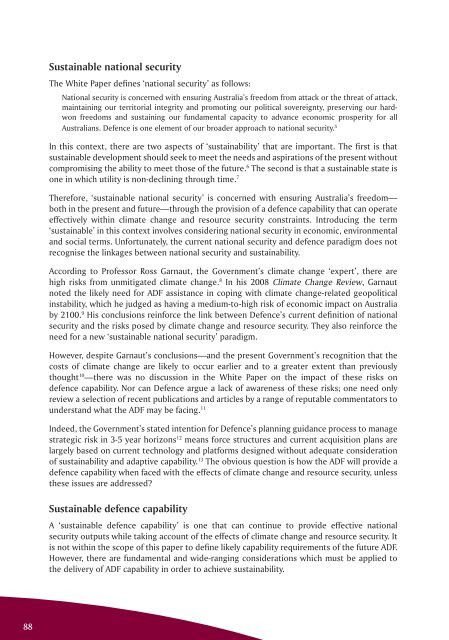ISSUE 183 : Nov/Dec - 2010 - Australian Defence Force Journal
ISSUE 183 : Nov/Dec - 2010 - Australian Defence Force Journal
ISSUE 183 : Nov/Dec - 2010 - Australian Defence Force Journal
You also want an ePaper? Increase the reach of your titles
YUMPU automatically turns print PDFs into web optimized ePapers that Google loves.
Sustainable national securityThe White Paper defines ‘national security’ as follows:National security is concerned with ensuring Australia’s freedom from attack or the threat of attack,maintaining our territorial integrity and promoting our political sovereignty, preserving our hardwonfreedoms and sustaining our fundamental capacity to advance economic prosperity for all<strong>Australian</strong>s. <strong>Defence</strong> is one element of our broader approach to national security. 5In this context, there are two aspects of ‘sustainability’ that are important. The first is thatsustainable development should seek to meet the needs and aspirations of the present withoutcompromising the ability to meet those of the future. 6 The second is that a sustainable state isone in which utility is non-declining through time. 7Therefore, ‘sustainable national security’ is concerned with ensuring Australia’s freedom—both in the present and future—through the provision of a defence capability that can operateeffectively within climate change and resource security constraints. Introducing the term‘sustainable’ in this context involves considering national security in economic, environmentaland social terms. Unfortunately, the current national security and defence paradigm does notrecognise the linkages between national security and sustainability.According to Professor Ross Garnaut, the Government’s climate change ‘expert’, there arehigh risks from unmitigated climate change. 8 In his 2008 Climate Change Review, Garnautnoted the likely need for ADF assistance in coping with climate change-related geopoliticalinstability, which he judged as having a medium-to-high risk of economic impact on Australiaby 2100. 9 His conclusions reinforce the link between <strong>Defence</strong>’s current definition of nationalsecurity and the risks posed by climate change and resource security. They also reinforce theneed for a new ‘sustainable national security’ paradigm.However, despite Garnaut’s conclusions—and the present Government’s recognition that thecosts of climate change are likely to occur earlier and to a greater extent than previouslythought 10 —there was no discussion in the White Paper on the impact of these risks ondefence capability. Nor can <strong>Defence</strong> argue a lack of awareness of these risks; one need onlyreview a selection of recent publications and articles by a range of reputable commentators tounderstand what the ADF may be facing. 11Indeed, the Government’s stated intention for <strong>Defence</strong>’s planning guidance process to managestrategic risk in 3-5 year horizons 12 means force structures and current acquisition plans arelargely based on current technology and platforms designed without adequate considerationof sustainability and adaptive capability. 13 The obvious question is how the ADF will provide adefence capability when faced with the effects of climate change and resource security, unlessthese issues are addressed?Sustainable defence capabilityA ‘sustainable defence capability’ is one that can continue to provide effective nationalsecurity outputs while taking account of the effects of climate change and resource security. Itis not within the scope of this paper to define likely capability requirements of the future ADF.However, there are fundamental and wide-ranging considerations which must be applied tothe delivery of ADF capability in order to achieve sustainability.88
















